Best triathlon bags in 2024: 17 options rated and reviewed
A triathlon transition bag will make your racing life easier and can double as a travelling or commuting companion. We put 17 options to the test

Laces, energy gels, triathlon watches – a triathlon bag (also called transition bag) may not be a mandatory purchase for your racing endeavours. In the past we’ve seen, and used, holdalls, plastic boxes and bin bags, all with varying degrees of success.
However, a triathlon-specific bag will make your life a whole lot easier, so much so that you’ll wonder how you previously survived without one.
They can also act as a badge of honour, signalling to fellow multisporters that you’re not only a triathlete in the pool, but also in the departure lounge and city centre cycle lane. But what should you look for in a triathlon bag?
What to look for in the best triathlon bags
A designated waterproof wetsuit compartment – whether built-in or removable – is ideal for any race involving open-water swimming, preventing your kit and car boot from becoming a soggy mess post-race.
Separate pockets for race fuel, admin (entry forms and race licence), tools and water bottles are highly recommended, while comfy straps are ideal for the often long walk (hello Windsor Triathlon) from the race car park to the transition area.
Also, try to remember that a transition bag doesn’t have to be just for race day, with many of those on test here being versatile enough to use for commuting, the gym and swim sessions.
And it’s worth noting airlines’ cabin bag limits if you have international ventures planned post-coronavirus. These vary from airline to airline and seem to be shrinking, meaning some of the bags tested here could be destined for the hold, which will incur extra charges.
Best triathlon bags for 2024
Huub TT Bag Limited Edition

- £99.99
Huub’s stylish TT (‘transition three’) bag won our April 2020 group test and similarly impresses here. Key features include a 40-litre capacity, a clever mesh foldaway helmet cradle and both wet and dry sections.
The bottom wet compartment was large enough for all my soggy swim kit and kept it completely away from dry stuff.
The main bag is split into two, which meant I could easily separate my bike and run kit, while the gold lining made it easy to spot things inside.
Multiple small pockets are handy and you also get two mesh bottle storage areas on the sides.
The materials all feel top quality, while padded straps and a cushioned back panel make it comfortable.
This is a bag designed by a brand that really understands triathlon and, although roomy enough for all my kit, it wasn’t unwieldy.
Verdict: A stylish and quality triathlon bag with easy-to-use sections.
Score: 93%
Orca Transition Bag
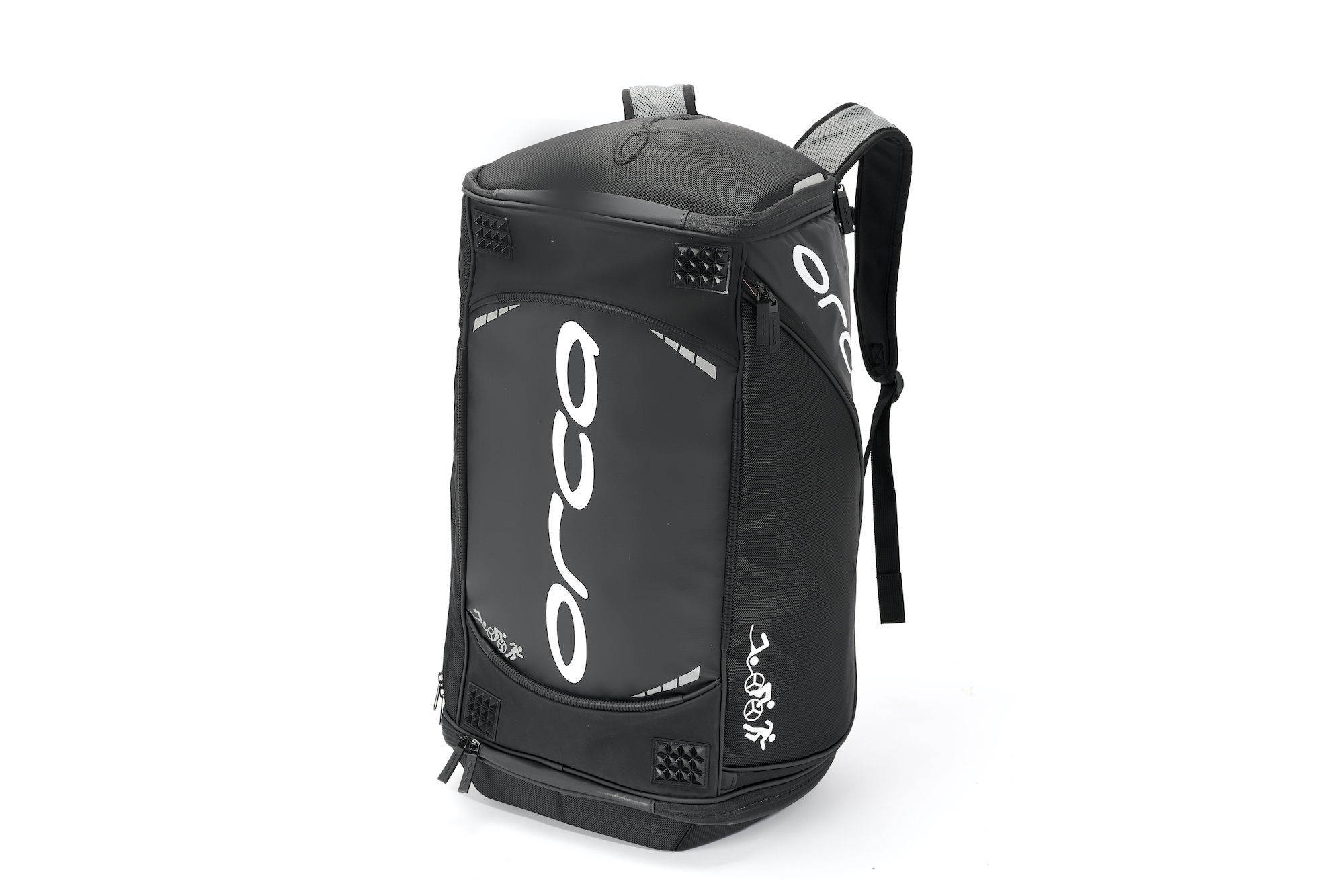
- £139
Like the Huub, this 70-litre bag feels well-constructed and offers a lot of clever storage solutions designed with triathletes in mind. A top pocket stores your bike helmet, while the bottom is wet storage for swim gear.
Meanwhile a genius section opens up to house two pairs of bike/run shoes with Velcro pop-up separators, also keeping mud off your apparel. The padded/shell helmet area is a great addition.
It’s easy to find what you’re looking for and a bright green lining helps with visibility. Two padded straps allow you to carry the bag as a rucksack, while one large strap converts it to a duffle bag.
There are multiple small pockets, too, including a padded pocket for sunnies. Overall this is a superbly-designed bag, but my only caveat was it felt a little large/heavy and unwieldy for this 5ft6in female tester.
Verdict: Huge triathlon bag with a pocket for everything, but a little heavy.
Score: 88%
Aptonia Triathlon Bag 35L
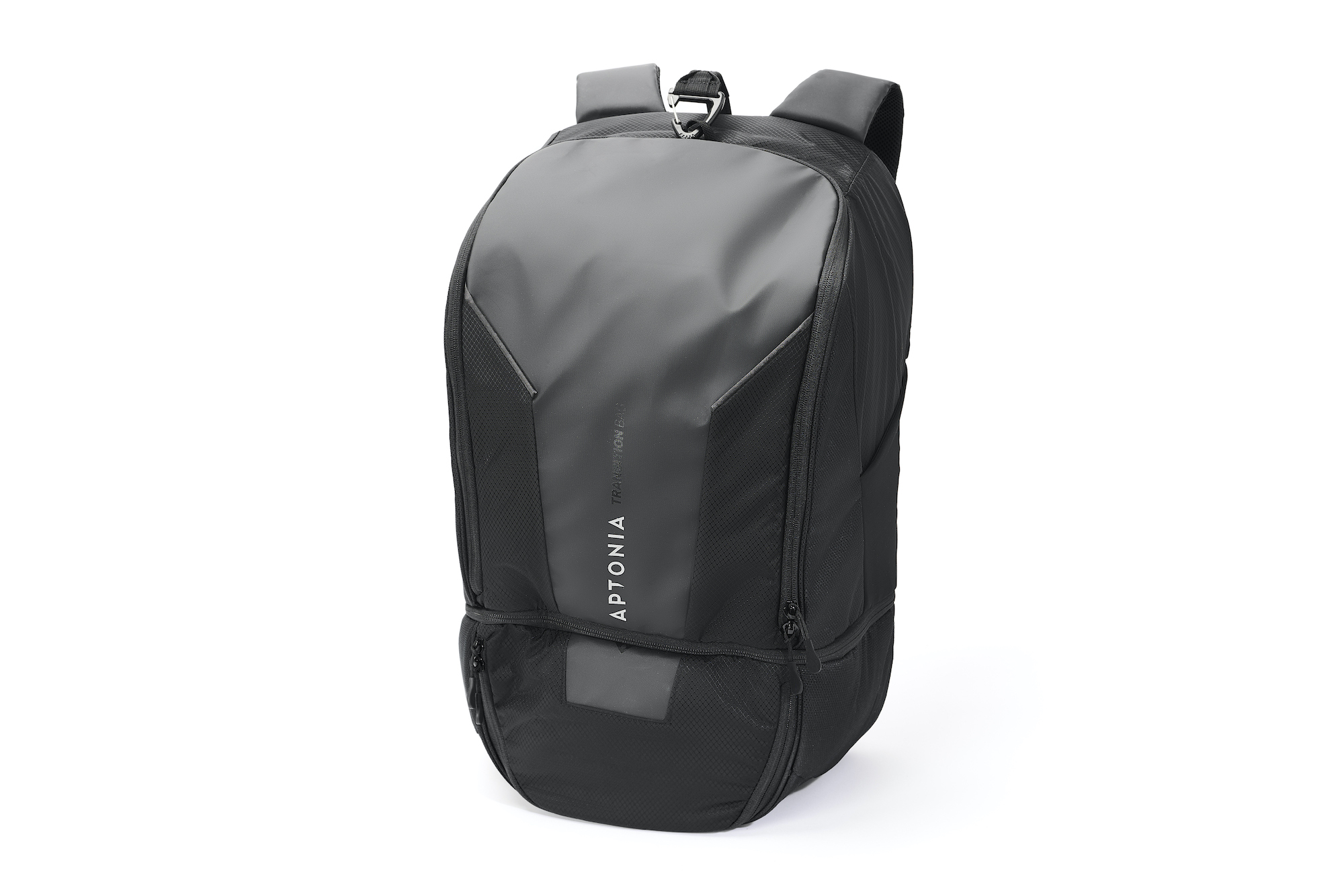
- £49.99
Not only is this one of the cheapest options on test, but the 35-litre capacity is also among the smallest, so it was a bit of a squeeze for this tester’s size 11 shoes and kit. This isn’t helped by the lack of external helmet storage.
The design allows you to separate your gear out by discipline, with a swim compartment at the bottom that zips off entirely, though it’s not waterproof, so you may end up with damp legs. However, it is separated from the rest of the bag by a water-resistant fabric, which did its job. You can also unzip the front, giving you access to the whole main compartment.
There are a number of mesh pouches inside and out, but I’d have liked more zip pockets for secure storage and a padded option for sunnies. The backpack straps are comfortable, while the bag also keeps its shape well.
Verdict: A little small, but good organisation and a decent triathlon bag for the price.
Score: 84%
Montane Transition 60L

- £80
Like some of the others here, the Transition 60L isn’t tri-specific, but is a durable bag, with a tough, weather resistant outer. This 60-litre version provides more than enough space for everything you’d need on race day, with a large opening that’s easy to pack gear in and out of.
That said, there’s limited organisation. Within this space you’ll find two zip pockets, ideal for smaller items, and two straps that you can clip together over your kit, which I found helpful for keeping the bike helmet in place.
However, there’s no dedicated pocket for a bottle, nowhere padded for sunnies, nor anywhere separate for you to house wet or dirty kit. Additional features such as multiple grab handles and straps that can be used as a backpack or as a holdall were welcome.
Verdict: Good space but not tri-specific and lacks organisation.
Score: 74%
Roka Utility Pack
- Buy now from Roka

- £210
This Roka really does scream quality. With its fleece-lined inner pockets and outer utility hook, it covers a range of uses. Especially convenient is the function to fully unzip and lay flat – ideal for organising transition kit within the multiple inner compartments.
Another key feature is the water-resistant pocket for wet gear, which can easily be pulled inside-out via an inner tab for quick drying after use. The bag itself kept contents dry even in a heavy downpour.
Though 30 litres, I found the Roka to be a veritable Tardis, easily fitting all my swim-run gear for a brick session, while the back panels with rigid handle make the bag easy to wear and move around.
One gripe is the top pocket intended for eyewear would benefit from a more rigid casing, but this isn’t a deal-breaker.
Verdict: Premium multi-purpose bag with matching price tag.
Score: 92%
Speedo Teamster Rucksack

- £48 / $80
Speedo’s 35-litre bag is primarily designed for swim-training needs. A wet section at the bottom is practical for stashing used kit, with a smaller ‘dirt bag’ that can be clipped inside or to the outside of the bag.
There are smaller side and front pockets for valuables, plus a mesh bottle pocket, but the inside of the bag has no compartments aside from a laptop sleeve, so not perfect for multisport use.
Speedo has added a ‘bleacher seat’ removable foam panel zipped in the back of the bag. It’s intended for sitting on, though I found it more useful as back padding.
Ergonomic back panelling, waist and chest straps allow for comfortable use even when carrying heavy gear. I like the water-repellent material coating the bottom of the bag, though the exterior shell doesn’t withstand a downpour.
Verdict: Good quality and price, just not for multisport use.
Score: 72%
Zone3 Transition

- £95 / $150
We’ve used previous editions of the 40-litre Zone3 Transition bag for years and can vouch for its durability.
A key change with this new model is a division of the main compartment, enhancing race-day convenience because of the ability to file swim, bike and run kit into different areas (swim kit is stored in the waterproof compartment).
The middle section’s ability to open out also makes it adept for lying flat on pool benches or in transition. Neat touches include a phone pocket with earphone outlet, the ability to stand the bag up and a reinforced lid for helmet protection.
A downside of the latter, however, is that it adds to the bag’s bulk, which means it’s not ideal for commuting (the split compartment also makes it laptop unfriendly) and a struggle to fit into smaller pool lockers.
Verdict: A stylish classic for race day, edged by Huub and Roka for everyday use.
Score: 88%
Dhb Transition Bag
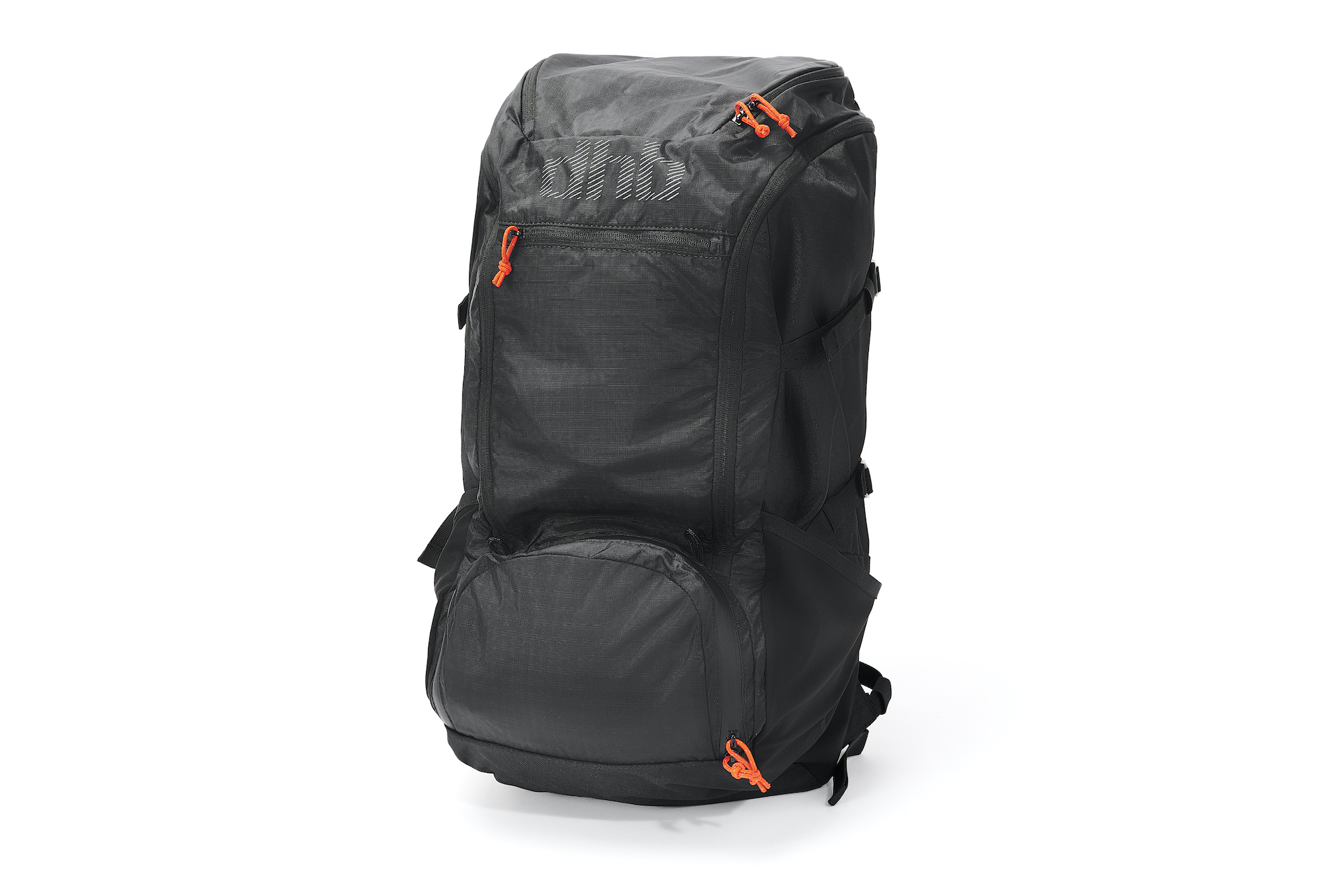
- £75
With a 35-litre capacity, this dhb bag is slightly smaller than the Huub but comes in £25 cheaper. The ripstop fabric lacks the high-quality feel of the Huub, but on the plus side is lightweight. You get a pull-out bike helmet cradle on the front, a large top pocket and a waterproofed wet-kit section at the bottom.
The entire front of the bag zips down, meaning it’s easy to see everything stashed inside without rooting around, but a coloured lining would have helped further. The many compartments, although cleverly-designed, were a bit tricky to use as they didn’t retain much shape.
There’s also no padded pocket for sunnies, which is a shame. I liked the large, colourful zip pulls, while large inner pockets were handy for shoe storage.
A padded back panel and straps keep the bag comfortable.
Verdict: Lots of good triathlon functionality, but construction a bit floppy.
Score: 78%
Aquasphere Transition Bag 35L

- £184.99 / $199.99
At 35L, this stylish pack is among the smallest on the market. That said, I managed to fit all my race-day kit into it, but it was a bit of a stretch with my size UK11 footwear and men’s medium wetsuit.
The good news is that organisation is fantastic. There’s a zip pouch on the top and an elasticated mesh pouch on the front, both of which are handy for small items.
There’s also an elasticated pocket on one side of the bag, which just about takes two bidon water bottles.
In the back, there’s a zipped laptop pouch, which also houses a small dry bag for you to store your wet kit. The latter was just about big enough to take my wetsuit.
The front of the bag folds down entirely, giving you easy access to various compartments.
In the flap there are two handy mesh pockets, while the main part of the bag then has one large compartment (which’ll take a helmet and wetsuit or shoes), plus two smaller pockets, which are elusively deep and managed to take a pair of shoes each.
Meanwhile, the bright internal colour helps with finding things easily and the structured sides aid with packing and unpacking.
The shoulder straps are comfortable, and there’s also a chest strap and hip belt, which is handy for taking the weight off your shoulders.
All in all, this is a fantastic transition bag, but it does come with a high price tag.
Verdict: Stylish and clever storage – almost a perfect product from Aquasphere.
Score: 90%
Sundried 50L Triathlon Backpack
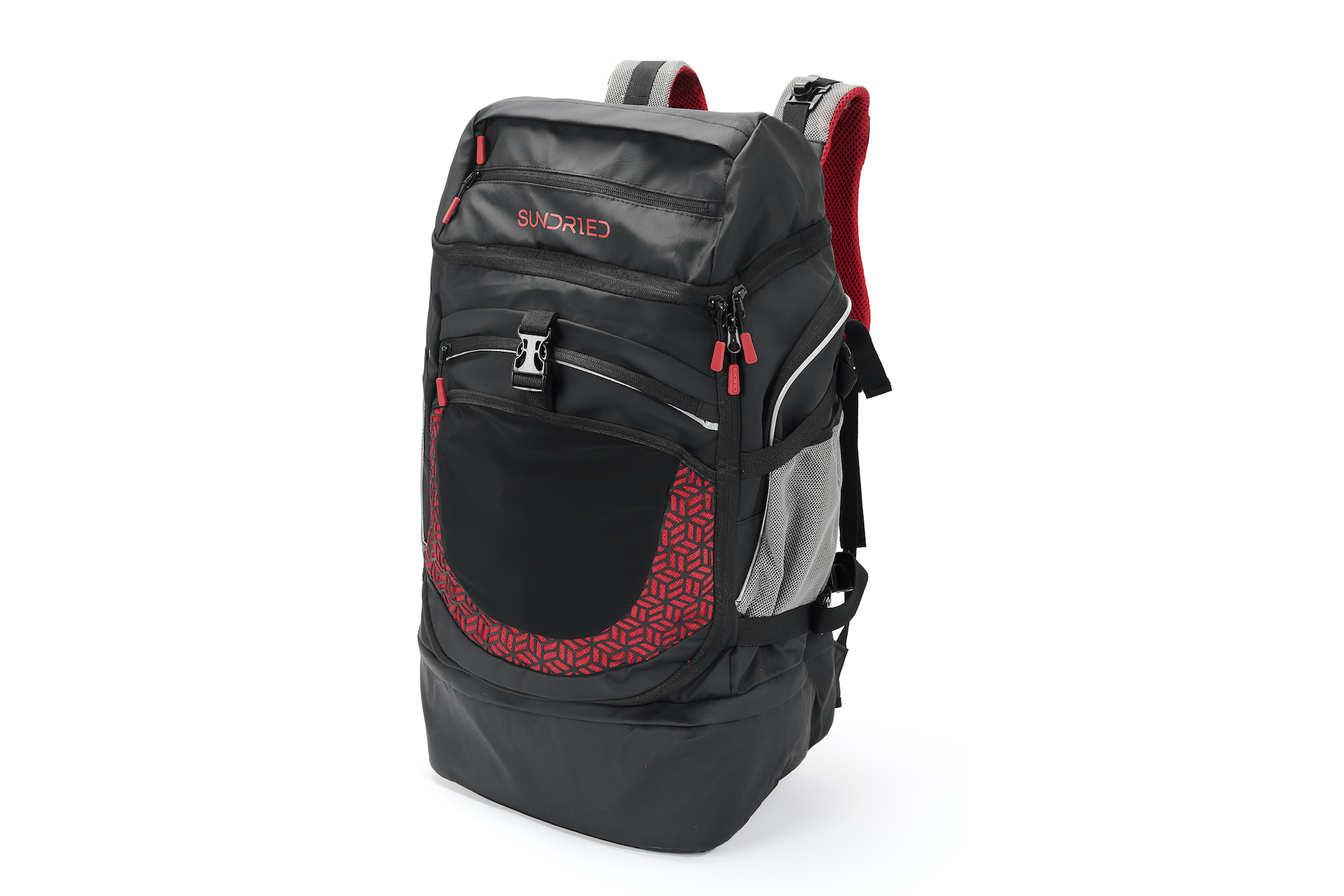
- £88 / $110.98
I don’t think Sundried could have squeezed more features into this backpack if they tried. There are pockets galore. It’s a little overkill, but you may welcome the vast options for organisation.
Happily, there’s a roomy zipped section at the bottom for housing kit separately, but it’s not waterproof, and inside the main compartment there’s no way to separate bike and run kit.
Meanwhile, there’s a stretch pocket on the front for a helmet. Both the front and the top of the main compartment zips away, which is handy for finding kit quickly, but the zips don’t feel the most secure and the bag lacks rigidity.
Despite being relatively lightweight, the size and sheer number of straps on this bag make it feel cumbersome, but the shoulder and hip straps ensure you can carry it like a backpack in comfort.
Verdict: A feature-heavy triathlon bag, but lacks finesse. Not cheap, either.
Score: 80%
Stolen Goat Triathlon Transition Bag

- £110 / $145
This transition bag takes a more traditional design and doesn’t quite look as slick as the Aquasphere.
It does, however, have an extra 20L of capacity and that’s noticeable when packing it, as it swallowed up all of my race-day kit with ease.
In fact, I had plenty of space to spare. The main compartment can be separated into three thanks to dividers, but I opted for two spaces in order to more easily fit my size UK11 shoes.
There’s also a separate compartment on the bottom of the bag designed for wet or dirty kit.
It can be zipped away from the bag entirely and also has drainage holes, but it’s not entirely waterproof.
Meanwhile, a large elastic pocket on the front of the bag will easily swallow your helmet, and a large zip pocket on each side of the bag would happy take two 600ml bidon water bottles each, plus other small items.
Organisation isn’t quite as slick as the Aquasphere and there are no internal zip pockets, but it still works rather well, and a bright internal colour helps you find things.
There’s less structure to this bag, so it can feel floppy at times, while the back system is also more basic with limited cushioning.
There’s no hip belt either, but you can stow the shoulder straps and use it as a holdall. At £110, it’s also still pricier than many other accomplished options.
Verdict: Spacious and multifunctional, but not as refined as the Aquasphere.
Score: 84%
Castelli Gear Duffle Bag 2

- £100 / $109.99
Castelli has designed this bag as ‘an overflow bag for a three-week stage race’, but there’s a lot to like for triathletes here, too.
The 50-litre capacity is roomy enough to get all your gear in and has a handy wide opening zip.
But like the Under Armour, most of that room is in one large single duffel area. The red lining helps with inner visibility, though, and there’s a massive mucky shoes area which can be used for wet kit.
However, it lacks the impermeable nature of more swim/tri-specific bags. In addition, there’s one zippy external pocket and a mix of internal mesh stuff pockets.
That price tag is a stumbling block for such a simple item, though, especially when you can get the equivalent size (medium) version of the Under Armour on test here (58-litre) for much less.
Verdict: Nice size but lacks tri-specific features and is pricey.
Score: 72%
Under Armour Undeniable Duffle 4.0 XL

- £55
The XL version of Under Armour’s duffle bag is absolutely huge, with a 145-litre capacity. Smaller sizes are available, which is a plus, as if you compare the bag volume needed by a petite athlete with a small shoe size to a larger athlete, it makes sense to offer a range.
This is more of a gym bag than a triathlon bag, but if you don’t want the varied pockets of some of the more complex bags on test, it may be an attractive option. The bag is water resistant, has two large zip-down front pockets and one soft inner pocket (though this only has a flap closure).
There’s a separate storage area for mucky shoes, which you could use for swim kit, but it has no waterproof lining. The price point is good for a massive bag, though it only has a hand or single shoulder strap and can’t be carried as a rucksack.
Verdict: Giant capacity but not tri-specific; good value if you have loads of kit.
Score: 75%
OMM RaceBase 70

- £90
Here we have another bag that’s like a duffel in style and function. This option from OMM comes with a 70-litre capacity, which is plenty of room for you to fit all of your kit in.
To be honest, it’s probably overkill for most triathletes. The result is that it can be tough to sufficiently pack the bag in a way that stops your precious kit sliding and banging around.
One thing I was pleased to see, though, is a separate compartment dedicated entirely to wet or dirty kit, which worked well.
This proved big enough to take a damp men’s wetsuit in size medium, with room to spare.
That being said, I was disappointed to see only one, zipped mesh pocket in the lid, meaning there’s limited options for storing and organising smaller items. The outer is durable and sheds water well.
Verdict: Loads of space and waterproof compartment, but limited organisation
Score: 78%
The Blue Kitbrix

- £99.90 / $129 (per brick)
KitBrix’s modular design allows you to create a storage solution to suit your needs, as each 20-litre bag can be zipped up together. They are a touch under £65 each though, so it can get expensive.
One bag on its own is certainly not going to provide enough space for all of your tri kit, but two together would prove sufficient. The modular design would also mean you can easily keep wet or dirty kit in one bag and dry kit in another, while a variety of internal zip pockets and external mesh pouches provide storage solutions for race admin and smaller items.
The bag is robust in its construction, offering good protection against the elements, but the zip isn’t the smoothest and the bags aren’t the most comfortable to carry, either. There’s a shoulder strap, but the boxy design makes it feel bulky and awkward.
Verdict: A solid option if you buy two, but not the most comfortable to carry.
Score: 77%
Topeak PakGo GearPack
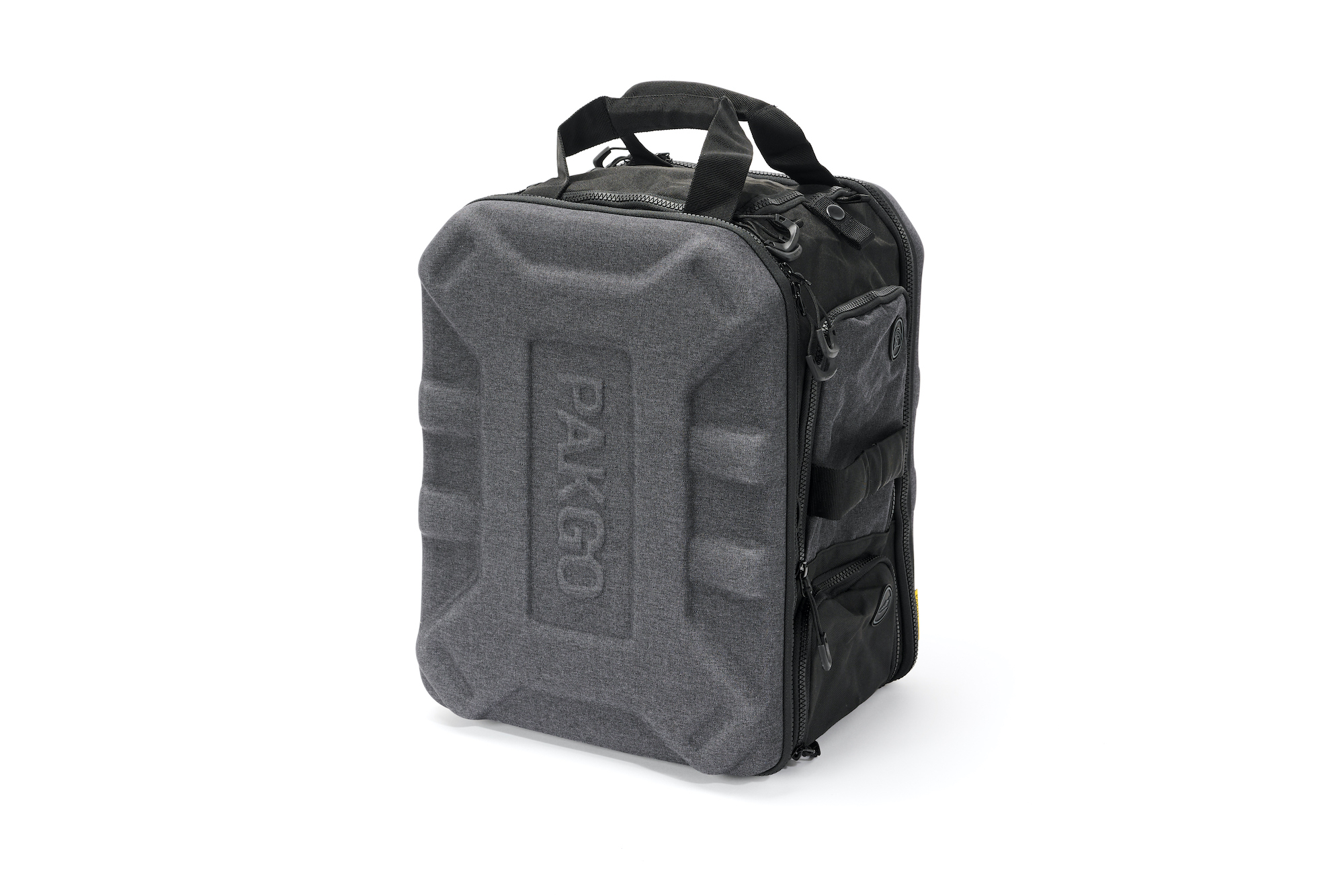
- £129.99
The GearPack is cube-shaped with shell sides and a flexible middle so it can be packed small to store/stash away (handy if your transition has size limits), but then pulls out to create a kind of portable kit locker.
With three main sections comprising a mucky shoes storage area, bike helmet section and apparel section, it’s nicely divided up for athletes.
There are then six additional pockets for smaller items. There’s also a twin strap that can be clipped on to turn it into a rucksack, which is handy if you need your hands free.
At a max capacity of 38 litres it’s among the smaller on test, but an external helmet clip frees up the internal pocket.
One extra nifty feature is the two sides also fold down, allowing you to use the central area for storage and the two sides to neatly lay your gear out on.
Verdict: Unusual design but surprisingly nifty and easy to use.
Score: 90%
Zoot Ultra Tri Bag

- £145 / $160
The canvas fabric makes the Ultra Tri stand out from much of the competition and, the bulbous protective helmet compartment aside, it ticks the aesthetic boxes.
It also ticks race-day boxes, with an internal checklist of race items, secure bottle storage, multiple mesh pockets, and a sizeable and removable dry bag for wet kit. It opens out fully – suitcase style – which is a huge bonus for overseas multisport adventures.
The comfy straps and ergonomic back panels also make it ideal for long journeys. Being 42-litre and 62cm tall could cause issues with the more draconian of airline staff.
The lack of suitability for commuting and pool or gym sessions is also worth noting.
Verdict: Superior style and function, yet the sizing lacks everyday versatility
Score: 83%







